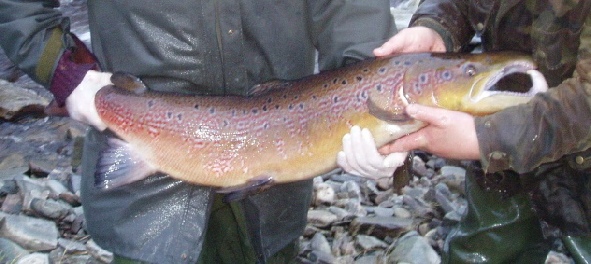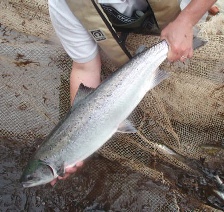Atlantic Salmon (Salmo salar)
Healthy salmon populations are found in all of the major catchments in west Sutherland, although numbers are reduced compared to earlier records from the 1970s. As a result the catch and release policy is an invaluable fishery management tool for salmon conservation, encouraging a steady increase in stocks across the area.
Salmon can be distinguished from trout by their more streamlined body shape and narrower ‘wrist’ (the area behind the tail). They also have a smaller mouth and larger fins with fewer, if any, markings below the lateral line.
|
|
Salmon spawn between November and early January in west Sutherland waters, and the eggs are deposited in redds in the river gravels. The eggs hatch around February time and the alevins survive on their yolk sacs. In the spring the fry emerge from the redds and start to migrate downstream burrying in gravels as they look for suitable feeding grounds.
Once the fry reach a certain size and develop prominent markings down their side they are known as parr. Generally the fish spend two to three years in freshwater before migrating to sea.
Prior to migration the parr develop a silvery appearance and become smolts which are able to tolerate brackish waters as they adapt to life in saltwater. The main smolt run occurs in May on the west coast. Time spent feeding at sea varies from one year (grilse) to up to four years (multi sea winter salmon) before the fish return to freshwater to spawn.
|
|
After spawning, surviving adults (kelts) return to the sea to recover before returning to spawn a second time. It is estimated that approximately 5 % of salmon have spawned previously.
See also under publications:
- Fishery Management Plan
- Catch and Release Guidance ASFB/RAFTS
 |
| Cock salmon in breeding colours |




